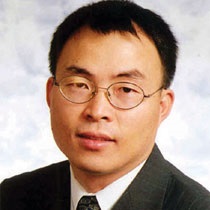Prof. Zixiang Xiong
Title: Fundamental Limits on Energy Consumption in Wireless Network
Bio: Zixiang Xiong received the Ph.D. degree in Electrical Engineering in 1996 from the University of Illinois at Urbana-Champaign. From 1995 to 1997, he was with Princeton University, first as a visiting student, then as a research associate. From 1997 to 1999, he was with the University of Hawaii. Since 1999, he has been with the Department of Electrical and Computer Engineering at Texas A&M University, where he is a professor and an associate department head. He spent his sabbatical leaves at Stanford University in spring 2010 and at Monash Univeristy, Australia during the 2017-2018 academic year.
He received an NSF Career Award in 1999, an ARO Young Investigator Award in 2000, and an ONR Young Investigator Award in 2001. He is co-recipient of the 2006 IEEE Signal Processing Magazine best paper award, top 10% paper awards at the 2011 and 2015 IEEE Multimedia Signal Processing Workshops, an IBM best student paper award at the 2016 IEEE International Conference on Pattern Recognition, and the best demo paper award at the 2018 IEEE International Conference on Multimedia and Expo. He served as associate editor for the IEEE Trans. on Circuits and Systems for Video Technology (1999-2005), the IEEE Trans. on Image Processing (2002-2005), the IEEE Trans. on Signal Processing (2002-2006), the IEEE Trans. on Systems, Man, and Cybernetics (part B) (2005-2009), and the IEEE Trans. on Communications (2008-2013). He is currently an associate editor for the IEEE Trans. on Multimedia. He is a fellow of the IEEE.
Abstract: What is the minimum energy required to transport one bit of information over a wireless network? In this talk we will explore this question from a fundamental information theory point of view. We will discuss how network topology, interference, and cooperation affects energy, and how the information theory insights can be used in designing networks. We will first outline results on the limits of energy per bit in networks when there are no constraints on bandwidth or delay. We will next show how these results change when there is a bandwidth constraint, and show that the effect of interference on energy consumption can be drastically reduced through interference alignment. We will show that a delay constraint quite dramatically increases the energy required per bit. Finally, we will discuss how more realistic hardware models affect energy consumption.
*Joint work with Anders Host-Madsen
Prof. Gil Zussman
Title: The COSMOS Wireless Testbed and Experimentation with Compact Full-Duplex Wireless
Bio: Gil Zussman received the Ph.D. degree in Electrical Engineering from the Technion in 2004. Between 2004 and 2007 he was a Postdoctoral Associate at MIT. Since 2007 he has been with Columbia University where he is now a Professor of Electrical Engineering and Computer Science (affiliated faculty), and member of Data Science Institute. His research interests are in the area of networking, and in particular in the areas of wireless, mobile, and resilient networks. He has been an associate editor of IEEE/ACM Transactions on Networking, IEEE Transactions on Control of Network Systems, IEEE Transactions on Wireless Communications, and Ad Hoc Networks, and the Technical Program Committee (TPC) co-chair of ACM MobiHoc’15 and IFIP Performance 2011. Gil received the Knesset (Israeli Parliament) award for distinguished students, two Marie Curie fellowships, the Fulbright Fellowship, the DTRA Young Investigator Award, and the NSF CAREER Award. He was the PI of a team that won the 1st place in the 2009 Vodafone Americas Foundation Wireless Innovation Project competition and is the Columbia PI of the COSMOS project. He is a co-recipient of seven best paper awards, including the ACM SIGMETRICS’06 Best Paper Award, the 2011 IEEE Communications Society Award for Advances in Communication, and the ACM CoNEXT’16 Best Paper Award.
Abstract: This talk will provide an overview of the COSMOS testbed, that is being deployed as part of the NSF Platforms for Advanced Wireless Research (PAWR) program, and of one of the first testbed experiments that will focus on full-duplex wireless.
COSMOS (Cloud-Enhanced Open Software-Defined Mobile-Wireless Testbed for City-Scale Deployment) is being deployed in West Harlem (New York City) by Rutgers, Columbia, and NYU in partnership with NYC, CCNY, U. Arizona, IBM, and Silicon Harlem. It targets the technology “sweet spot” of ultra-high bandwidth and ultra-low latency, a capability that will enable a broad new class of applications including augmented/virtual reality and cloud-based autonomous vehicles. Realization of such high bandwidth/low latency wireless applications involves research not only on faster radio links, but also on the system as a whole including aspects such as spectrum use, networking, and edge computing. Hence, the key enabling technologies will include software-defined radios, mmWave radios, optical/SDN x-haul network, edge cloud, and testbed control and management software.
One of the first COSMOS pilot experiments will focus on full-duplex (FD) wireless, since FD communication, namely, simultaneous transmission and reception on the same frequency channel, can substantially improve spectrum efficiency. Within the Columbia Full-duplex Wireless: From Integrated Circuits to Networks (FlexICoN) project, we have been focusing on Integrated Circuit (IC) implementations that are appropriate for mobile and small-form-factor devices. We will present the FlexICoN Gen-1 FD transceiver that has been integrated in the ORBIT testbed. Then, we will present the FlexICoN Gen-2 FD transceiver and the obtained experimental results. We will also present analytical results regarding rate gains when considering these IC-based FD implementations, as well as results regarding scheduling in heterogeneous networks with both FD and legacy half-duplex users. Both the Gen-1 and Gen-2 transceivers will be integrated in the COSMOS testbed to allow experimental evaluations of FD-related algorithms at the higher layers.
The COSMOS testbed design and deployment is joint work with the COSMOS team (www.cosmos-lab.org). The full-duplex results are based on joint works with Tingjun Chen, Mahmood Baraani Dastjerdi, Jelena Diakonikolas, Jin Zhou, Javad Ghaderi, and Harish Krishnaswamy.



